Related Research Articles

A molecular cloud, sometimes called a stellar nursery (if star formation is occurring within), is a type of interstellar cloud, the density and size of which permit absorption nebulae, the formation of molecules (most commonly molecular hydrogen, H2), and the formation of H II regions. This is in contrast to other areas of the interstellar medium that contain predominantly ionized gas.
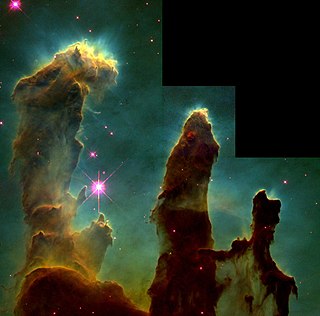
A nebula is a distinct body of interstellar clouds.

A planetary nebula is a type of emission nebula consisting of an expanding, glowing shell of ionized gas ejected from red giant stars late in their lives.

Star formation is the process by which dense regions within molecular clouds in interstellar space, sometimes referred to as "stellar nurseries" or "star-forming regions", collapse and form stars. As a branch of astronomy, star formation includes the study of the interstellar medium (ISM) and giant molecular clouds (GMC) as precursors to the star formation process, and the study of protostars and young stellar objects as its immediate products. It is closely related to planet formation, another branch of astronomy. Star formation theory, as well as accounting for the formation of a single star, must also account for the statistics of binary stars and the initial mass function. Most stars do not form in isolation but as part of a group of stars referred as star clusters or stellar associations.

In astronomy, the interstellar medium is the matter and radiation that exist in the space between the star systems in a galaxy. This matter includes gas in ionic, atomic, and molecular form, as well as dust and cosmic rays. It fills interstellar space and blends smoothly into the surrounding intergalactic space. The energy that occupies the same volume, in the form of electromagnetic radiation, is the interstellar radiation field.

The Triangulum Galaxy is a spiral galaxy 2.73 million light-years (ly) from Earth in the constellation Triangulum. It is catalogued as Messier 33 or NGC 598. The Triangulum Galaxy is the third-largest member of the Local Group of galaxies, behind the Andromeda Galaxy and the Milky Way. It is one of the most distant permanent objects that can be viewed with the naked eye.
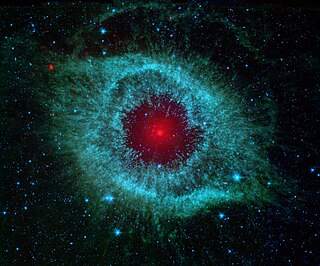
The Helix Nebula is a planetary nebula (PN) located in the constellation Aquarius. Discovered by Karl Ludwig Harding, probably before 1824, this object is one of the closest to the Earth of all the bright planetary nebulae. The distance, measured by the Gaia mission, is 655±13 light-years. It is similar in appearance to the Cat's Eye Nebula and the Ring Nebula, whose size, age, and physical characteristics are similar to the Dumbbell Nebula, varying only in its relative proximity and the appearance from the equatorial viewing angle. The Helix Nebula has sometimes been referred to as the "Eye of God" in pop culture, as well as the "Eye of Sauron".

An H II region or HII region is a region of interstellar atomic hydrogen that is ionized. It is typically a cloud in a molecular cloud of partially ionized gas in which star formation has recently taken place, with a size ranging from one to hundreds of light years, and density from a few to about a million particles per cubic cm. The Orion Nebula, now known to be an H II region, was observed in 1610 by Nicolas-Claude Fabri de Peiresc by telescope, the first such object discovered.
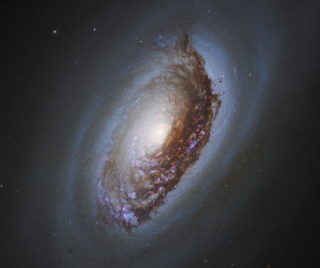
The Black Eye Galaxy is a relatively isolated spiral galaxy 17 million light-years away in the mildly northern constellation of Coma Berenices. It was discovered by Edward Pigott in March 1779, and independently by Johann Elert Bode in April of the same year, as well as by Charles Messier the next year. A dark band of absorbing dust partially in front of its bright nucleus gave rise to its nicknames of the "Black Eye", "Evil Eye", or "Sleeping Beauty" galaxy. M64 is well known among amateur astronomers due to its form in small telescopes and visibility across inhabited latitudes.

In theoretical astrophysics, there can be a sphere of ionized hydrogen around a young star of the spectral classes O or B. The theory was derived by Bengt Strömgren in 1937 and later named Strömgren sphere after him. The Rosette Nebula is the most prominent example of this type of emission nebula from the H II-regions.

In astronomy, metallicity is the abundance of elements present in an object that are heavier than hydrogen and helium. Most of the normal physical matter in the Universe is either hydrogen or helium, and astronomers use the word "metals" as a convenient short term for "all elements except hydrogen and helium". This word-use is distinct from the conventional chemical or physical definition of a metal as an electrically conducting solid. Stars and nebulae with relatively high abundances of heavier elements are called "metal-rich" in astrophysical terms, even though many of those elements are nonmetals in chemistry.

NGC 7027, Also known as the Jewel Bug Nebula, is a very young and dense planetary nebula located around 3,000 light-years from Earth in the constellation Cygnus. Discovered in 1878 by Édouard Stephan using the 800 mm (31 in) reflector at Marseille Observatory, it is one of the smallest planetary nebulae and by far the most extensively studied.
An HI region or H I region (read H one) is a cloud in the interstellar medium composed of neutral atomic hydrogen (HI), in addition to the local abundance of helium and other elements. (H is the chemical symbol for hydrogen, and "I" is the Roman numeral. It is customary in astronomy to use the Roman numeral I for neutral atoms, II for singly-ionised—HII is H+ in other sciences—III for doubly-ionised, e.g. OIII is O++, etc.) These regions do not emit detectable visible light (except in spectral lines from elements other than hydrogen) but are observed by the 21-cm (1,420 MHz) region spectral line. This line has a very low transition probability, so it requires large amounts of hydrogen gas for it to be seen. At ionization fronts, where HI regions collide with expanding ionized gas (such as an H II region), the latter glows brighter than it otherwise would. The degree of ionization in an HI region is very small at around 10−4 (i.e. one particle in 10,000). At typical interstellar pressures in galaxies like the Milky Way, HI regions are most stable at temperatures of either below 100 K or above several thousand K; gas between these temperatures heats or cools very quickly to reach one of the stable temperature regimes. Within one of these phases, the gas is usually considered isothermal, except near an expanding H II region. Near an expanding H II region is a dense HI region, separated from the undisturbed HI region by a shock front and from the H II region by an ionization front.
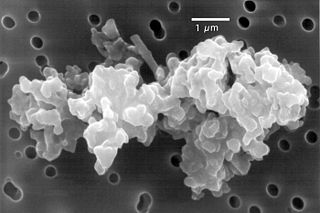
Cosmic dust, also called extraterrestrial dust or space dust, is dust which exists in outer space, or has fallen on Earth. Most cosmic dust particles measure between a few molecules and 0.1 mm. Larger particles are called meteoroids. Cosmic dust can be further distinguished by its astronomical location: intergalactic dust, interstellar dust, interplanetary dust and circumplanetary dust.
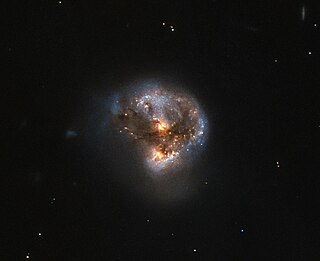
A megamaser is a type of astrophysical maser, which is a naturally occurring source of stimulated spectral line emission. Megamasers are distinguished from other astrophysical masers by their large isotropic luminosity. Megamasers have typical luminosities of 103 solar luminosities (L☉), which is 100 million times brighter than masers in the Milky Way, hence the prefix mega. Likewise, the term kilomaser is used to describe masers outside the Milky Way that have luminosities of order L☉, or thousands of times stronger than the average maser in the Milky Way, gigamaser is used to describe masers billions of times stronger than the average maser in the Milky Way, and extragalactic maser encompasses all masers found outside the Milky Way. Most known extragalactic masers are megamasers, and the majority of megamasers are hydroxyl (OH) megamasers, meaning the spectral line being amplified is one due to a transition in the hydroxyl molecule. There are known megamasers for three other molecules: water (H2O), formaldehyde (H2CO), and methine (CH).
A champagne flow is an astrophysical event whereby an HII region created inside a molecular cloud from ionization due to a recently formed star expands outward until it reaches the interstellar medium, at which point the ionized hydrogen gas bursts outward like an uncorked champagne bottle. This event is also sometimes called a Blister.
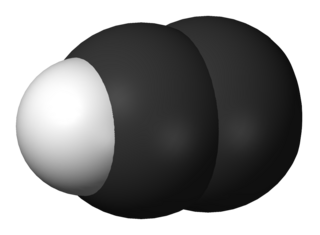
The ethynyl radical is an organic compound with the chemical formula C≡CH. It is a simple molecule that does not occur naturally on Earth but is abundant in the interstellar medium. It was first observed by electron spin resonance isolated in a solid argon matrix at liquid helium temperatures in 1963 by Cochran and coworkers at the Johns Hopkins Applied Physics Laboratory. It was first observed in the gas phase by Tucker and coworkers in November 1973 toward the Orion Nebula, using the NRAO 11-meter radio telescope. It has since been detected in a large variety of interstellar environments, including dense molecular clouds, bok globules, star forming regions, the shells around carbon-rich evolved stars, and even in other galaxies.

The cyano radical (or cyanido radical) is a radical with molecular formula CN, sometimes written •CN. The cyano radical was one of the first detected molecules in the interstellar medium, in 1938. Its detection and analysis was influential in astrochemistry. The discovery was confirmed with a coudé spectrograph, which was made famous and credible due to this detection. ·CN has been observed in both diffuse clouds and dense clouds. Usually, CN is detected in regions with hydrogen cyanide, hydrogen isocyanide, and HCNH+, since it is involved in the creation and destruction of these species (see also Cyanogen).

Alexander Godfried Gerardus Maria (Xander) Tielens is an astronomer at Leiden Observatory, Leiden University, in the Netherlands. In 2012 he received the highest distinction in Dutch science, the Spinoza Prize.

The Antlia-Sextans Group is a small grouping of galaxies in the constellations Hydra, Sextans, Antlia and Leo. It is generally considered to be at the very edge of the Local Group and thus part of it. However, other researchers indicate it is an independent group, and thus the nearest group to the Local Group. It is, on average, approximately 4.3 million light-years away from the Milky Way.
References
- 1 2 Hollenbach, D.J.; Tielens, A.G.G.M. (1999). "Photodissociation regions in the interstellar medium of galaxies". Reviews of Modern Physics. 71 (1): 173–230. Bibcode:1999RvMP...71..173H. doi:10.1103/RevModPhys.71.173.
- ↑ Tielens, A.G.G.M. (1993). "Photodissociation regions and planetary nebulae". Planetary Nebulae: Proceedings of the 155 Symposium of the International Astronomical Union. 155: 155–162. Bibcode:1993IAUS..155..155T. doi: 10.1017/S0074180900170330 .
- 1 2 Hollenbach, D. J.; Tielens, A. G. G. M. (1997). "Dense photodissociation regions". Annual Review of Astronomy and Astrophysics. 35: 179–215. Bibcode:1997ARA&A..35..179H. doi:10.1146/annurev.astro.35.1.179.
